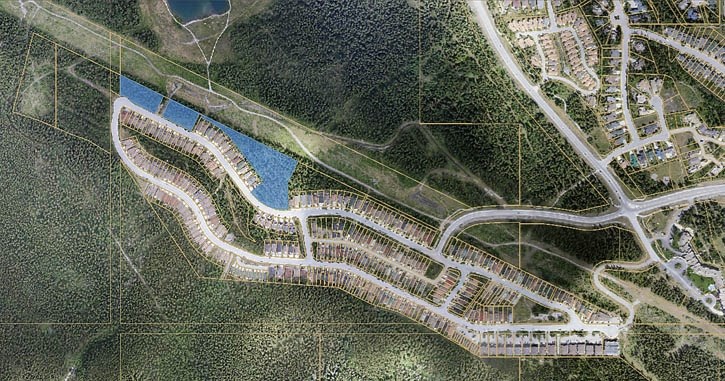CANMORE – The public will have to wait six more weeks to find out the fate of a controversial development project in the Peaks of Grassi neighbourhood.
After a closed door meeting on Tuesday (Feb. 5), council unanimously agreed to postpone its decision until March 19 to give themselves more time to consider the public’s concerns, which were laid bare a week earlier during a lengthy public hearing.
“This is a new application to a new council and it’s important that as a new council we consider this application carefully and take sufficient time to understand the many reports provided, the public input received and ultimately make a decision that recognizes our responsibility to balance the rights of individuals with the over all greater public interest,” said Mayor John Borrowman.
It’s the third time the proponents of the project have applied to have four acres of land along Lawrence Grassi Ridge rezoned from urban reserve to a direct control district.
If the rezoning bylaw is approved, the developers intend to build 27 residential units and up to 13 secondary suites on three parcels of land, including seven perpetual affordable housing units.
Pierre Doyon, one of three proponents of the project, said he was disappointed council didn’t make a decision.
“I think the application speaks for itself,” said Doyon, immediately after the meeting.
“It’s the most studied and reviewed infill development project and administration knows that, so now it’s a question of the town debating community benefits.”
At the centre of that debate is whether or not the seven perpetual affordable housing units included in the development is enough of a community benefit to tip the balance in favour of the project.
“There is a public interest component in this that council needs to balance,” said Michael Fark, general manager of infrastructure.
“They need to balance the overall community needs for affordable housing, which is the interest council has indicated they have in this project, with the local community concerns around the impact this development will have on people’s neighbourhood in that location.”
Prior to holding the in camera meeting, the mayor asked administration if it would be possible to add more perpetually affordable housing units to the project.
Fark told council it would be complicated, but didn’t entirely shut the door on the possibility either.
“That is not something that council can control through the district; through the land use proposal that is before them. It essentially requires a form of discussion with the landowner and Canmore Community Housing Corporation to see if there is any opportunity to do that,” Fark said.
Doyon said he respected the Town’s position to try and get additional affordable housing units added to the project, however he stood by his proposed development as submitted.
Mountain creek flood risk remains a concern
Mark Gruman, who filed a successful legal challenge against the application in 2016, said council’s decision to postpone the vote was “very positive.”
“Hopefully, this will give administration the opportunity to follow up on some of the issues recently raised both at and after the public hearing,” wrote Gruman.
“Particularly with respect to the flood zone, we are confident that if the Town obtains competent legal advice as requested by those opposed to the rezoning they will confirm that flood mitigation cannot occur without the approval of Alberta Environment and Parks and as a result no building of perpetually affordable housing units will occur in the flood zone for months, if ever.
“Under this circumstance, rezoning to allow the development of the other the parcels should not be allowed.”
Tracey Woitenko, a development planner with the Town, said recent reports completed on the steep creek risk in the area indicated the proposed development is in a low hazard zone and under the municipal development plan the proposed project would only require onsite mitigation.
That being said, she told council that because the flood risk impacts the existing neighbourhood the proposed development created an opportunity to work with the developer to create off-site mitigation to protect both existing and new development.
One of the off-site proposals is to build a berm above the neighbourhood, which would be located on municipal land.
“It is not administration’s current understanding that a water act approval is required, however once we get to the subdivision stage and it is determined that the berm will actually go ahead, as we always do, we will have a conversation with the province about the project and should a water act approval be required we will happily pursue that process,” said Fark.
He emphasized that there is no requirement that the berm needs to be built before construction begins and therefore it should not impact council’s decision.
During the council meeting, administration also provided a brief overview of the dozens of other submissions and concerns they heard from members of the public during the public hearing on Jan. 31.
Those concerns included risks from wildfire, traffic, blasting, the impact on wildlife, the environment, views from Quarry Lake, perpetually affordable housing, the 1998 settlement agreement, secondary suites, impact on adjacent neighbours and the sustainability screening report.
“These are valid concerns for members of the public to raise, however it is the position of administration that these have been adequately addressed through the technique components,” said Fark.
“However, what is the remaining component is the fact there was significant opposition within the local neighbourhood and even from the broader community to this application moving forward and that in and of itself, regardless of technical considerations, is a legitimate consideration for council.”




